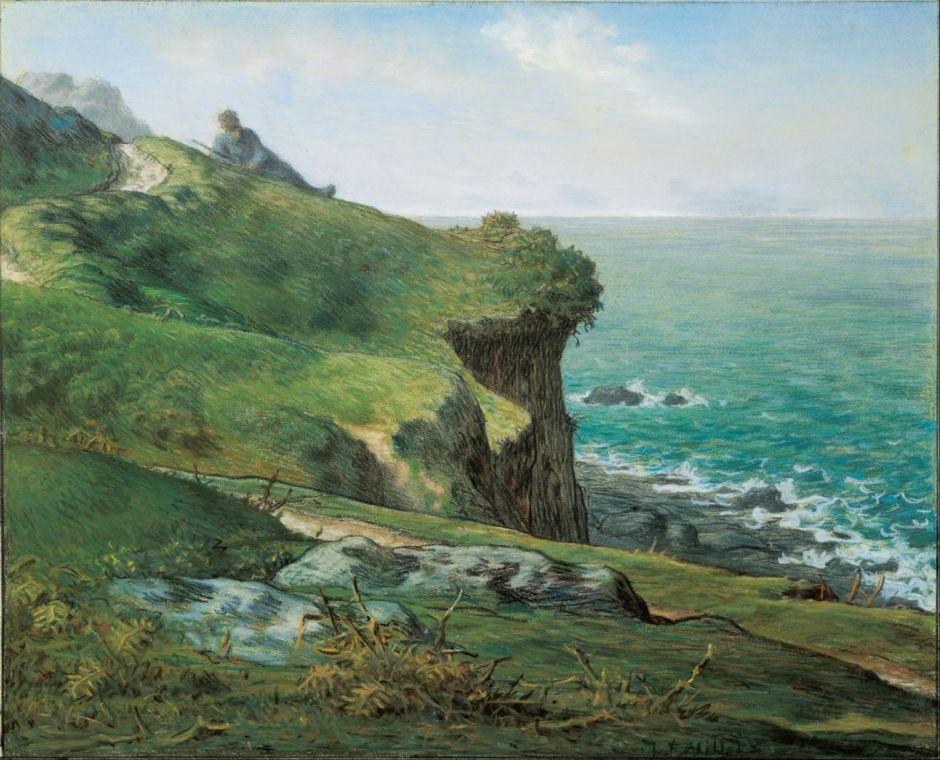In the first of these three articles examining the Wanderer theme in paintings, I looked at its origin with Hieronymus Bosch, and its development by Caspar David Friedrich and his pupil Carl Gustav Carus. In the second article, I moved on to Thomas Fearnley, whose paintings start this third and final article as I move on into the later years of the nineteenth century.

Fearnley’s Old Birch Tree at Sognefjord (1839) features two small figures at its centre, and many other absorbing details such as the smoke rising from the chimney of the house on the other side of the small bay. Look closer, at its detail (below) and both figures wear hats, the one on the left being bright red, as in some of his earlier Wanderers.

Fearnley continued to use these figures to draw the viewer closer and closer into his paintings.

In The Duck Hunter, Fearnley has camouflaged the figure to increase the challenge made of the viewer.

The last of these Romantic landscapes with wanderers comes from a successor to Friedrich’s tradition, painted by Carl Friedrich Lessing. In his Silesian Landscape from 1841, the artist returns to paint the great floodplain near where he was born. In all that great expanse of countryside there is but a single figure, who is walking along the rough track into its dusk light.

By the middle of the nineteenth century, other landscape painters such as Alexandre Calame In the Bernese Oberland remixed the same elements with a view of one of the higher peaks of the Bernese Alps. A lone figure is seen to the left of the broken pine tree in the foreground, this time facing the viewer rather than a Rückenfigur.
Wanderers had also entered the literary tradition, perhaps most famously in John Bunyan’s allegorical hero Christian, in his Pilgrim’s Progress, from 1678.

Samuel Palmer’s Christian Descending into the Valley of Humiliation from 1848 shows Christian making his solitary way down into a valley. On the left are buildings with a dominating tower, set amid trees. In the far distance are hills, within which is a brightly lit town. Otherwise the hills are swathed in the indigo clouds of bad weather, which ends above the horizon to the right, where the sky forms a bright line. Christian is clad in the armour and bears the shield and sword given earlier in Bunyan’s book, by the virtues of Discretion, Prudence, Piety and Charity.
Palmer’s friend William Blake (who had died 21 years before this was painted) had also illustrated Pilgrim’s Progress; whilst there may have been an element of tribute in this painting, its style and influence by Salvator Rosa, Claude, Turner, and Linnell are distinctive. It also shows a recurrent theme in Palmer’s later work, that of the lonely tower, and may also refer to another, that of clouds piled towards heaven – as well as the Wanderer.

The Wanderer also appears in some surprising places. Martín Rico’s early landscape painted Near Azañón (1859) places the lone Wanderer in arid country in his native Spain. As with Calame’s Alpine figure, this Wanderer faces the viewer rather than looking away.

Towards the end of the nineteenth century, the Wanderer underwent further transformation. Here he is in one of Jean-François Millet’s occasional landscapes of the coastline near his home village. The Cliffs of Gréville (1871) is a fine pastel depiction which surprises by its unusual scaling and distance effects. At first sight, the more distant clifftop seems quite far away, but the Wanderer recumbent on the skyline establishes that it is in fact quite close to the viewer.
My last example is from the early years of the twentieth century, which has clearly evolved from Friedrich’s Wanderer above the Sea of Mists from almost a century earlier.

In this third version of his View into Infinity from 1905, standing on a rock pinnacle above Ferdinand Hodler’s sea of fog is a naked young man. Behind him long red mountain ridges pierce through the fog, and the pale lemon sky of dawn has parallel strips of red cloud. He not only looks us straight in the face, but is now stark naked.

